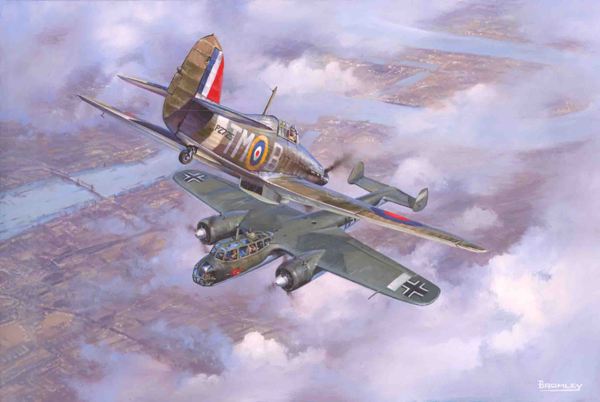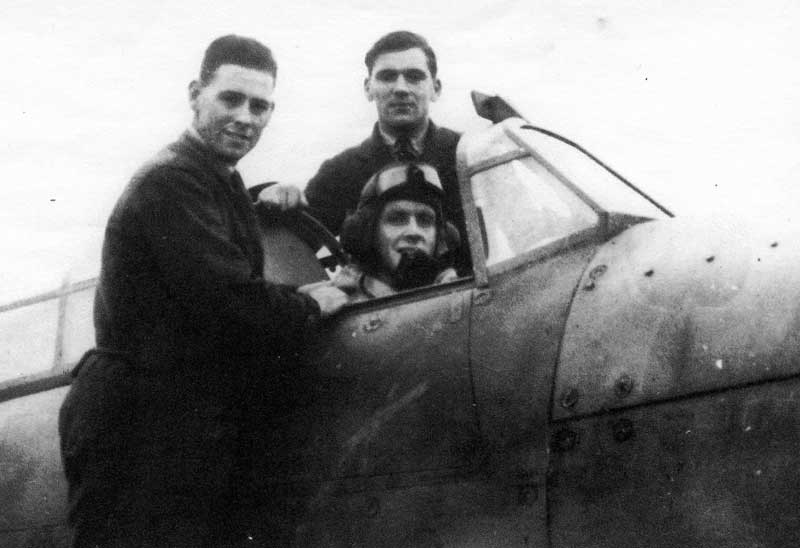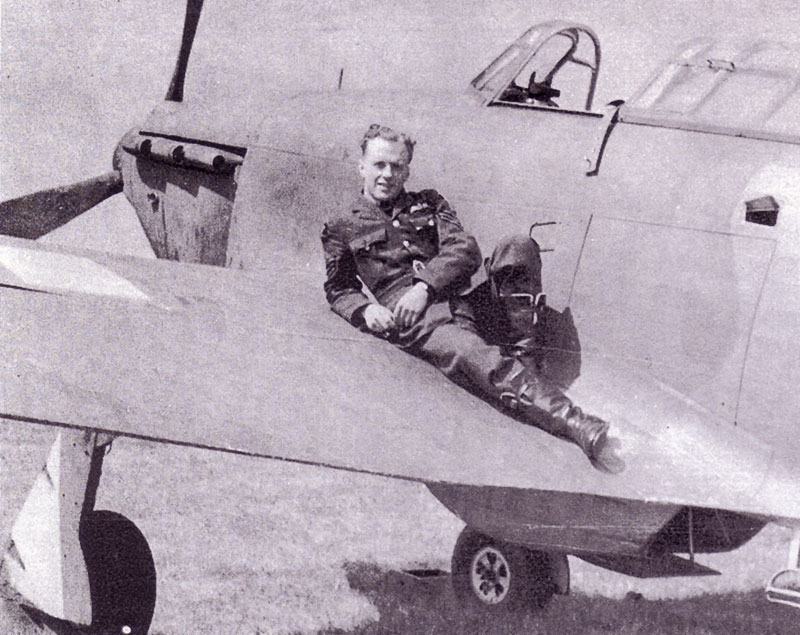Wallasey Hero of the Battle of Britain |
|
 |
 Ray Holmes in the cockpit of Hurricane P2725 TM-B at Hendon |
|
Flight
Sergeant
Ray Holmes
ran out of ammunition when he was in
the thick of a 'dog-fight' over London on Sunday, 15 September,
1940. So he decided to ram his Hurricane fighter into a Dornier
bomber. This caused both planes to crash, but Holmes and some of
the crew members of the bomber managed to bail out. Holmes
landed near the Oval Cricket Ground and it is said that he then
called in at a nearby pub for a quick pint. All this caught the
imagination of the public and he was feted as having saved
Buckingham Palace from being attacked.
Flight Lieutenant Ray Holmes, who died in 2005, delivered the coup de grace to a German Dornier 17 bomber near Buckingham Palace in one of the most celebrated episodes during the Battle of Britain.
The German bomber had taken off from France at 10am on Sunday
September 15 1940, which is now regarded as the climax of the
battle. After joining up with a formation at 15,000 ft it headed
for central London, its crew avoiding RAF fighters when crossing
the coastline near Dungeness; then an engine started to
malfunction, and the bomber dropped behind the main force. As it
neared its target it came under concentrated attack from
fighters near Battersea. It was set on fire by Hurricanes of 310
(Czech) Squadron; and two of the crew baled out.
Holmes, a sergeant at the time, then appeared on the scene to
deliver a further attack, causing the Dornier to break up, and
forcing the German pilot to bale out. A large piece of the
bomber fell in the forecourt of Victoria Station, a scene
depicted - with considerable artistic licence - in the film
Battle of Britain. The stone facade of the station bore the
scars for more than 40 years.
Afterwards, Holmes stated that his aircraft had hit something
during the attack, and he was forced to bale out over Chelsea.
On landing in Hugh Street, he was told by onlookers that his
enemy had crashed at Victoria. He was led to the Orange Brewery
100 yards down Pimlico Road for a swift brandy before being
dispatched to Chelsea Barracks. Following a visit to an Army
doctor and then the mess for a few more drinks and a bit of
warranted line-shooting, a taxi took him back No 504 Squadron at
RAF Hendon. The attack, during which Buckingham Palace was
bombed, captured the imagination of the public and subsequent
historians.
Last year archaeologists unearthed
parts of Holmes's Hurricane for a Channel 5 television
documentary, in which Holmes visited the site near Buckingham
Palace Road and was shown the fighter's control column or
"joy-stick" which he had last held 64 years earlier.
Appropriately, the firing button was still set to "FIRE". The aircraft's engine was recovered, and it is now displayed at the Imperial War Museum. The son of a journalist, Raymond Towers Holmes was born on August 20 1914 at Wallasey, Cheshire. He attended Calday Grange Grammar School, West Kirby, where he excelled at cricket and rugby, then became a crime reporter. He joined the RAFVR as an airman pilot in 1937 and trained at Prestwick and Barton in Lancashire. Holmes went to No 504 Squadron at Wick in June 1940. The squadron flew south to Hendon in early September, and it was soon involved in some of the heaviest fighting of the Battle of Britain. After he was commissioned in June 1941, 'A' Flight of No 504 became No 81 Squadron at Leconfield, East Riding, and the pilots were kitted out for an unknown destination. They flew to Glasgow, and embarked in the aircraft carrier Argus, which carried crated Hurricanes. On September 1, the squadron flew off in groups and landed at Vaenga airfield near Murmansk, northern Russia. Operations were flown until November, when Holmes and his fellow pilots taught Russians to fly the fighters. In December the RAF contingent sailed for England, leaving the Hurricanes and their equipment for the Russian Air Force. After returning home, Holmes spent the next two years training student pilots before he went back to operations, flying high-altitude Spitfires with No 541 photographic reconnaissance squadron at Benson. During this period he acted as a courier, carrying papers for Winston Churchill when he was preparing for the Potsdam Conference. Holmes left the RAF in November 1945, having been mentioned in dispatches and given the Air Efficiency Award. After the war Holmes turned down a suggestion that he become an airline pilot, and returned to journalism in Liverpool, where he established his own agency which specialised in court reporting. He also took agricultural photographs in colour when the technology was in its infancy, retaining his own laboratories for processing and working closely with Kodak, which was impressed with his innovative ideas. But eventually he could not keep up both journalism and photography, and opted for the former. Taking notes with a fountain pen in perfect shorthand, Holmes became a father figure at Liverpool Crown Court, teaching young reporters the proper way to bow before a judge. After retiring at 80, he maintained a keen interest in journalism while devoting time to golf, woodwork and gardening. He wrote an autobiography, Sky Spy (1989). In 2004 the Wirral Borough Council bestowed the Freedom of the Borough on Holmes, the chief executive stating that he could "think of no one upon whom this honour could have been more fittingly bestowed". On the day Holmes died, flags flew at half-mast in his honour in the Wirral, and his widow received a message from Buckingham Palace expressing the Queen's sadness on hearing of his death. Raymond Holmes married Elizabeth Killip in April 1941. After her death he married, in 1966, Anne Holmes, who survives him with two daughters from his first marriage, and a son and daughter from his second. Read more Stories like this in this book on the History of Wallasey http://www.amazon.co.uk/History-Wallasey-Small-Suburb-ebook/dp/B008CNYQSE/ref=sr_1_1?s=digital-text&ie=UTF8&qid=1340876056&sr=1-1  Ray Holmes 1941 |
|
|
Please help me to keep this site alive, no matter how small a donation, it all helps CONTACT |